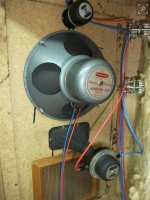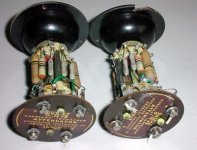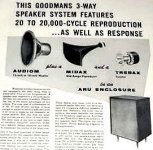The first edition of Gilbert Briggs' seminal book entitled 'Loudspeakers' was issued in May 1948. It was published by Wharfedale Wireless Works Limited, the company founded by Mr Briggs himself in order to manufacture loudspeakers.
The book originally appeared with 'cardboard backs' and had 78 pages. It developed over 10 years to 92 pages with minor revisions. A completely revised and enlarged edition comprising 336 pages was issued in October 1958.
During the following 4 years 'enough had happened' to warrant the release of a follow up book imaginatively titled 'More About Loudspeakers'. The first edition of this new volume was issued in March 1963 and comprised of 136 pages.
Many novice enthusiasts value these books for the way they provide a non-technical introduction to the design and performance of loudspeakers.
I own a pair of Wharfedale RS/12/DD (Roll Surround/12"/Double Diaphragm) drivers which were purchased in 1969 and subsequently housed in 'distributed port' type cabinets based on Briggs' design. Nearly 50 years later the speakers still give sterling service and, in my opinion, give some modern designs a run for their money!
The question I have for my fellow loudspeaker fanatics out there is this. How far do you think loudspeaker design has advanced in the 70 years since the release of Gilbert Briggs' first book on loudspeakers?
The book originally appeared with 'cardboard backs' and had 78 pages. It developed over 10 years to 92 pages with minor revisions. A completely revised and enlarged edition comprising 336 pages was issued in October 1958.
During the following 4 years 'enough had happened' to warrant the release of a follow up book imaginatively titled 'More About Loudspeakers'. The first edition of this new volume was issued in March 1963 and comprised of 136 pages.
Many novice enthusiasts value these books for the way they provide a non-technical introduction to the design and performance of loudspeakers.
I own a pair of Wharfedale RS/12/DD (Roll Surround/12"/Double Diaphragm) drivers which were purchased in 1969 and subsequently housed in 'distributed port' type cabinets based on Briggs' design. Nearly 50 years later the speakers still give sterling service and, in my opinion, give some modern designs a run for their money!
The question I have for my fellow loudspeaker fanatics out there is this. How far do you think loudspeaker design has advanced in the 70 years since the release of Gilbert Briggs' first book on loudspeakers?
The basics are still the same....advancements in computer based r&d, manufacturing, materials, and high power amplification have increased the bandwidth, linearity, and maximum clean output for a given enclosure volume.
Tech advancements have also made small wide bandwidth transducers available that weren't possible with the technology of the day. Large woofers and compression drivers aren't too different today but a small bluetooth boombox was simply a pipe dream.
Dispersion control is in a whole other world as well. I think the last two decades have seen more advancements and refinements than the previous 50 years. I'm only a 30y.o. hobbyist though, would be interesting to hear from long time industry experts.
Tech advancements have also made small wide bandwidth transducers available that weren't possible with the technology of the day. Large woofers and compression drivers aren't too different today but a small bluetooth boombox was simply a pipe dream.
Dispersion control is in a whole other world as well. I think the last two decades have seen more advancements and refinements than the previous 50 years. I'm only a 30y.o. hobbyist though, would be interesting to hear from long time industry experts.
I have the reprint from Speaker Builder, not sure which edition but there is so much basic stuff in it about acoustics and moving coil loudspeakers, especially the importance of cone profile in propagation of frequencies above the piston band, that I still think it's a good primer for folks who haven't been soaking up (often contradictory) information from books and magazines for decades.
its like a little blue comfort-blanket 😀 - plate-lens - blh - Briggs' "acoustic filter" A bygone era when pretty good drivers (and reasonably suitable cabinets for them were built) - Many of those low mass motors would not hold up under the rigors of today's "music" with near-sine bass drops.
I think the main difference between those days and now (or even 20 years later from the last edition of the book) is that in the old days there was the "art of experience". That was later replaced with "engineering methodology".
I put the milestone on the Thiele/Small papers that formed the basis of the engineering process.
I put the milestone on the Thiele/Small papers that formed the basis of the engineering process.
Hi SaSi!
Gilbert Briggs was a true pioneer. He had no 'rule book' and, as you say, advanced his business mainly through experience. His yardstick of success was simply the ability of his loudspeaker designs to reproduce music naturally.
Between 1954 and 1957, Mr Briggs gave 10 concert hall demonstrations in various cities, including London and New York. Recorded music from his platform speaker set-up was compared favourably with live music from an orchestra.
Without the benefit of modern technology, and like the designers of the Forth Bridge, Mr. Briggs' methodology was simply to over-engineer his products. Massive magnets, rigid die-cast chassis, aluminium voice coils and improved roll surrounds ensured the quality and longevity of his loudspeakers.
Of course, computerised design involving T/S parameters now permits loudspeakers to be more efficiently engineered to pre-determined price levels.
Gilbert Briggs was a true pioneer. He had no 'rule book' and, as you say, advanced his business mainly through experience. His yardstick of success was simply the ability of his loudspeaker designs to reproduce music naturally.
Between 1954 and 1957, Mr Briggs gave 10 concert hall demonstrations in various cities, including London and New York. Recorded music from his platform speaker set-up was compared favourably with live music from an orchestra.
Without the benefit of modern technology, and like the designers of the Forth Bridge, Mr. Briggs' methodology was simply to over-engineer his products. Massive magnets, rigid die-cast chassis, aluminium voice coils and improved roll surrounds ensured the quality and longevity of his loudspeakers.
Of course, computerised design involving T/S parameters now permits loudspeakers to be more efficiently engineered to pre-determined price levels.
Last edited:
I read the book "A pair of Wharfedales" by David Briggs a couple of years ago. It is an excellent biography of this great man and a very good write-up on the beginnings of the high fidelity.
It felt nice to read how people dedicated to innovation but hindered by the limitations of economy, technology and knowledge made advances.
That continued well into the 70s. Take the KEF 104/104aB for example. It looks bizzare today, with the B139 mounted horizontally widening the front baffle - when we now know it should be as narrow as possible. And the edges of the enclosure come forward by several millimeters. Which really doesn't help controlling diffraction.
The KEF Calinda shows these maladies eliminated and also shows how the integration between the tweeter and woofer, raising the emission axis upwards means the tweeter should be placed below the woofer.
All this is nice. But consider life at a time when sealing the enclosure by giving it a back cover was not considered a necessity. Open baffle loudspeakers were made and utilized long before sealed and ported ones became understood.
It felt nice to read how people dedicated to innovation but hindered by the limitations of economy, technology and knowledge made advances.
That continued well into the 70s. Take the KEF 104/104aB for example. It looks bizzare today, with the B139 mounted horizontally widening the front baffle - when we now know it should be as narrow as possible. And the edges of the enclosure come forward by several millimeters. Which really doesn't help controlling diffraction.
The KEF Calinda shows these maladies eliminated and also shows how the integration between the tweeter and woofer, raising the emission axis upwards means the tweeter should be placed below the woofer.
All this is nice. But consider life at a time when sealing the enclosure by giving it a back cover was not considered a necessity. Open baffle loudspeakers were made and utilized long before sealed and ported ones became understood.
Yes, Briggs was an inspiration to many of us and funny too.
A few weeks ago, Bolserst (a DIYaudio resident guru) shared some Briggs pages with me about electrostatic speakers, written just months after the first Quad. Very little missed his notice or comment apropos their sound and their place in the audio world.
Browsing a bit, I read his comments about BR enclosures. He mentioned port noises. Imagine that... folks were perceptive audio designers way back then.
I'm in the camp that feels little in Rice-Kellogg drivers or enclosures has improved since that time*. Fussing about a bit of mostly inaudible diffraction at the edges of an enclosure that may have gone unnoticed 50 years ago is silly compared to the major design issues that need to be addressed in sending a speaker out to the world.
B.
*my pre-1965 Stephens 150W seems to work just fine in my recently completed 17-foot pipe sub (see sub forum). BTW, anybody remember Briggs sewer pipe speaker?
A few weeks ago, Bolserst (a DIYaudio resident guru) shared some Briggs pages with me about electrostatic speakers, written just months after the first Quad. Very little missed his notice or comment apropos their sound and their place in the audio world.
Browsing a bit, I read his comments about BR enclosures. He mentioned port noises. Imagine that... folks were perceptive audio designers way back then.
I'm in the camp that feels little in Rice-Kellogg drivers or enclosures has improved since that time*. Fussing about a bit of mostly inaudible diffraction at the edges of an enclosure that may have gone unnoticed 50 years ago is silly compared to the major design issues that need to be addressed in sending a speaker out to the world.
B.
*my pre-1965 Stephens 150W seems to work just fine in my recently completed 17-foot pipe sub (see sub forum). BTW, anybody remember Briggs sewer pipe speaker?
Last edited:
In a lot of respects a long way. But there is still a lot of crap out there.
If I may add... we have gone from analog to digital, which some think it is a downgrade in sound quality, to the compressed formats which are in some cases terrible...so the industry make advances in speaker design and the recording industry makes a regression on the progress...go figure
I would say dome tweeters are the biggest innovation in the last 70 years of loudspeaker development.
Prolly so. But dome tweeters look exactly like the replaceable diaphragms in "ball park" horns sold by Western Electric in the 40s. BTW, they had edge-wound aluminum VCs.
B.
B.
Gilbert Briggs tested an assortment of the tweeters that had "made an appearance" at the time of writing of his book.
They included a Janzen electrostatic, an Ionophone plasma unit, an REC ribbon, a Goodmans pressure unit, and his own Wharfedale 3" paper cone with foam surround.
He was "amazed at the differences which were exposed" on test and wrote "So it must unfortunately be admitted that we are still some distance away from general perfection."
Plus ca change . . .
They included a Janzen electrostatic, an Ionophone plasma unit, an REC ribbon, a Goodmans pressure unit, and his own Wharfedale 3" paper cone with foam surround.
He was "amazed at the differences which were exposed" on test and wrote "So it must unfortunately be admitted that we are still some distance away from general perfection."
Plus ca change . . .
Oh yes in the pages I recently read, Briggs also commented on something he liked from a chap named Kelly who was in the process of offering his ribbon speaker to a firm named Decca.Gilbert Briggs tested an assortment of the tweeters that had "made an appearance" at the time of writing of his book.
They included a Janzen electrostatic, an Ionophone plasma unit, an REC ribbon, a Goodmans pressure unit, and his own Wharfedale 3" paper cone with foam surround....
OK, are we back to "what's new in the last 70 years..."?
B.
PS. As a long-time motorcycle and sports car enthusiast, I've long and often pondered what ever mutilated the once great British industrial world.
The Decca Keey ribbon evolved into the Decca London ribbon which is still amounst one of my favorite tweeters (no domes in that collection).
dave
dave
Prolly so. But dome tweeters look exactly like the replaceable diaphragms in "ball park" horns sold by Western Electric in the 40s. BTW, they had edge-wound aluminum VCs.
B.
Thanks. Interesting. I will look that up.
First I must say that a great deal of the musings in this thread are plain wrong.
To criticise the horizontal alignment of the ABR in a KEF 104ab is misunderstanding what it does. It scarcely has any output above 100Hz, so diffraction is hardly an issue. To say that dome tweeters are a huge advance in modern speakers is also dubious. I'd say the ring-radiator like the XT25 is a better candidate for genuine innovation. But that's just me. 😱
I always say if you see A PAIR OF WHARFEDALES in a junk shop, buy them. I do. I always have a look inside too. 😎
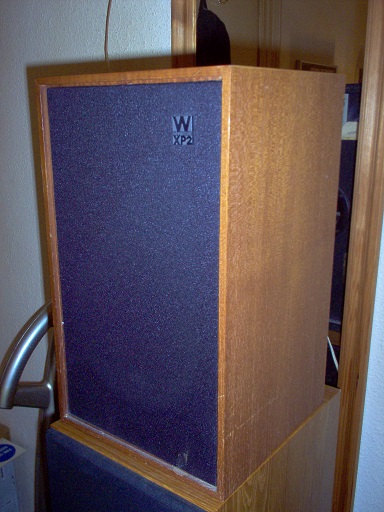
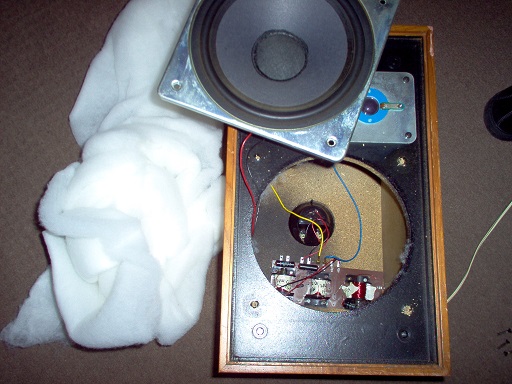
Wharfedale never aimed for the esoteric market in HiFi. More the speaker that ordinary people will be happy with. Gilbert Briggs was not your typical engineer. His guide, it seems, was always the overall listening experience. And he had good ears.
Lovers of things retro could do worse than spend time with Troels Gravesen. There is no doubt that those old speakers had some strengths. I still like those old-style big cones with cloth surrounds and transparent cloth dustcaps and cardboard formers. Vintage HiFi
The two best selling popular brands in the post-war period were probably Wharfedale and Goodmans. Lot to like with both. I happened to grow up listening to Goodmans, illustrated below for people who don't know what they were like. But I bought Wharfedales. I think Briggs understood the wife approval factor, aka WAF. 😀
To criticise the horizontal alignment of the ABR in a KEF 104ab is misunderstanding what it does. It scarcely has any output above 100Hz, so diffraction is hardly an issue. To say that dome tweeters are a huge advance in modern speakers is also dubious. I'd say the ring-radiator like the XT25 is a better candidate for genuine innovation. But that's just me. 😱
I always say if you see A PAIR OF WHARFEDALES in a junk shop, buy them. I do. I always have a look inside too. 😎
Wharfedale never aimed for the esoteric market in HiFi. More the speaker that ordinary people will be happy with. Gilbert Briggs was not your typical engineer. His guide, it seems, was always the overall listening experience. And he had good ears.
Lovers of things retro could do worse than spend time with Troels Gravesen. There is no doubt that those old speakers had some strengths. I still like those old-style big cones with cloth surrounds and transparent cloth dustcaps and cardboard formers. Vintage HiFi
The two best selling popular brands in the post-war period were probably Wharfedale and Goodmans. Lot to like with both. I happened to grow up listening to Goodmans, illustrated below for people who don't know what they were like. But I bought Wharfedales. I think Briggs understood the wife approval factor, aka WAF. 😀
Attachments
- Status
- Not open for further replies.
- Home
- Loudspeakers
- Multi-Way
- 70th Anniversary of 'Loudspeakers' by G A Briggs
